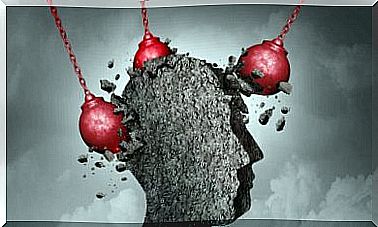Living With Anxiety And Depression

Two symptoms coexisting as two obscure entities of the same coin: anxiety and depression. Living under the absolute control of these two conditions completely limits the quality of life. In the field of mental health this reality is well known, as around 60% of people with depression also suffer from an anxiety disorder.
It’s not a trivial matter; in fact, the clinical symptoms associated with this type of psychological disorder can become chronic in many cases. However, for not seeking specialized help or for not having a valid and adequate diagnosis, it is common to find many patients who reach an extreme where the idea of suicide arises.
Irritability, malaise, anhedonia, guilt, negative feelings, despair… This person’s daily life, filled with anxiety and depression, gradually becomes a quicksand scenario where he sinks deeper with each moment.
These are very complex situations that require the best assistance, the best therapeutic approaches to respond to a fact that is undoubtedly seen more and more frequently.
Thus, in many of these cases we have before us a mixed anxiety-depressive disorder. It is a clinical reality in which different symptoms converge, different characteristics that professionals must identify as soon as possible.

Anxiety and depression in mixed anxiety-depressive disorder
The link between anxiety and depression is well known in the psychological and psychiatric fields. Furthermore, experts like David Barlow, director of the Center for Mood Disorders at Boston University, say that even from a neurobiological perspective, they seem to share the same processes.
Studies, such as the one carried out at Emory University (Atlanta, United States), reached revealing results. Both realities would have their origin in our cerebral amygdala. That is, the structure in which our “fear center” is located is sometimes very reactive. This causes any event or stimulus to be experienced disproportionately, accompanied by very intense negative emotions.
With depression, our reality is frozen. Suspended in a state where we feel helpless and hopeless. However, this excessive fear means that, in turn, we do not stop anticipating ideas, seeing tomorrow with a lot of anxiety, anguish and despair.
On the other hand, the reason why we came to develop these conditions or why we are more sensitive to suffering them would be, for many experts, a genetic factor, added to the context in which we live and the lack of tools to face different circumstances .
What are the symptoms of mixed anxiety-depressive disorder
The first question that may come to mind is: if I suffer from anxiety and depression, do I suffer from some kind of psychological disorder ? Well, before this question, we must understand that we are all capable of experiencing these realities at certain times in life.
The problem arises when these states become persistent and appear together. Clinical manifestations must coexist permanently (more than a month) and to the same degree. In addition, it is necessary that these characteristics appear:
- Problems with concentration and memory failure.
- Constant worry.
- Fatalistic thoughts, pessimism and despair.
- Sleep changes.
- Anhedonia (lack of motivation, vital impulse, energy and courage…).
- Irritability and constant bad mood.
- Feeling of uselessness, guilt, low self-esteem…
- Hypervigilance. Feeling of being always alert, with the feeling that something is going to happen…
- Gastrointestinal problems.
On the other hand, the most striking feature of this condition is the extreme that many patients can reach: lack of hygiene, social isolation, inability to work… Epidemiological data tell us that only 50% of people with this disorder are ever diagnosed in care primary (either because they do not seek it or because they are not referred to specialized professionals).

How to treat mixed anxiety-depressive disorder?
The therapeutic approach depends on many variables, but the most important is the personal reality of each patient. There will be those who present mild symptoms and therefore benefit from a psychological approach. In other cases, where the situation is more serious, psychological intervention will be complemented with a pharmacological intervention.
In any case, it is more convenient for patients to benefit from a multidisciplinary approach, without excluding, for example, social, care and psychoeducational aspects. A person with mixed anxiety-depressive disorder needs as much support as possible. These would, therefore, be the most common strategies:
- Cognitive-behavioral therapy (oriented towards cognitive restructuring, to reduce hypervigilance, fear, anxiety).
- Relaxation techniques.
- Mindfulness.
- Pharmacological treatment (antidepressants and anxiolytics).
- Psychoeducation: the patient learns the reality of his situation, understands what depression is, what anxiety is and what strategies he can use to treat and prevent them.

Finally, let’s dwell a little more on one aspect. We must keep in mind that many people suffer from anxiety and depression. However, the fact that these symptoms appear at the same intensity giving rise to mixed anxiety-depressive disorder is something more particular that, unfortunately, is not always properly identified. So don’t hesitate to seek expert help to always have the best answer, attention and guidance.









